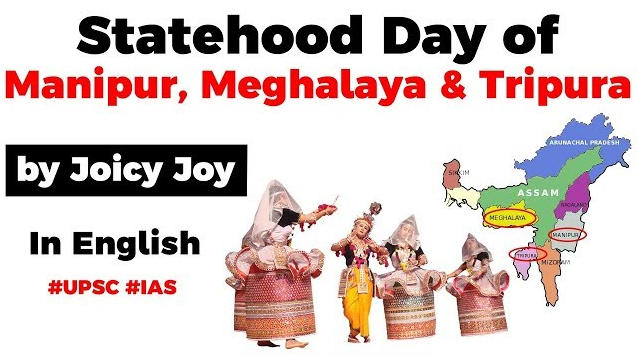Table of Contents
CURRENT AFFAIR
- On 21st January, 1972, all the three states became full- fledged states under the North Eastern Region (Reorganisation) Act, 1971.
- On the Statehood Day of Manipur, Meghalaya and Tripura (21st January), Prime Minister and other leaders praised the traditions and culture of the three northeast states.
BACKGROUND
- Before 15th August 1947, peaceful negotiations had brought almost all states whose territories were contiguous to the new boundaries of India, into the Indian Union.
- The rulers of most of the states signed a document called the ‘Instrument of Accession’ which meant that their state agreed to become a part of the Union of
Merger of Manipur with India
- A few days before Independence, the Maharaja of Manipur, Bodhachandra Singh, signed the Instrument of Accession with the Indian government on the assurance that the internal autonomy of Manipur would be maintained.
- Under the pressure of public opinion, the Maharaja held elections in Manipur in June 1948 and the state became a constitutional monarchy.
- Thus Manipur was the first part of India to hold an election based on universal adult franchise.
- In the Legislative Assembly of Manipur there were sharp differences over the question of merger of Manipur with India.
- The Government of India succeeded in pressuring the Maharaja into signing a Merger Agreement in September 1949, without consulting the popularly elected Legislative Assembly of Manipur.
Merger of Tripura with India
- Tripura was princely state till the merger with Indian union on 15th November, 1949.
- The last king Bir Bikram who was on the throne, immediately before India’s independence, died on 17th May, 1947.
- After his demise, his minor son Kirri Bikram Mannikya took the throne of Tripura kingdom, but he could not rule as he was minor.
- So his widow queen Kanchan Prabha took the charge of regency of Tripura and took over the administrative
- She was instrumental for Merger of Tripura kingdom in Indian Union.
Merger of Meghalaya into India
- In 1947 the rulers of the Garo and Khasi region acceded to the newly independent country of
- Meghalaya, a small hilly state located in the North Eastern Region of India, came into existence as an autonomous state within the state of Assam on 2 April 1970 comprising the United Khasi and Jaintia Hills and the Garo Hills districts.
1972
- The two Union Territories of Manipur and Tripura and the Sub-State of Meghalaya got statehood
Manipur: Jewel of India
- Manipur is a beautiful state surrounded by hill ranges and was rightly called the ‘Jewel of India’ by Pandit Jawaharlal Nehru.
- Manipur comprises 16 districts
- About 41.4 per cent of Manipuris are Hindus.
- Christianity is the religion of the majority of the population in the hill districts.
- ‘Raslila’, a classical dance performed by professional and accomplished dancers.
- Manipur has a rich history of traditional games and The modern game of Sagol Kangjei (Polo) is reported to have originated in Manipur.
Meghalaya: Abode of Clouds
- The state’s capital is Shillong.
- Meghalaya comprises the United Khasi Hills, Jaiñtia Hills and Garo Hills.
- Meghalaya has four major festivals: ‘Shad Suk Mynsiem’, also known as ‘Weiking dance’ and ‘Nongkrem dance’ (Khasis); ‘Wangala dance’, also known as ‘Hundred Drums festival’ of the Garos, and ‘Behdeiñkhlam festival’ of Jaiñtia
- English is the official and widely spoken language of the state, and Khasi and Garo are the associate official
Tripura: Land of Diversity
- The major languages spoken by the people of Tripura are Bengali, Kokborok and its variants, and Manipuri.
- Tripura is a small state, distinguished by its cultural similarity with neighbouring Bengal, trade routes with Bangladesh across the border and large potential of agricultural and industrial development.
- It is home to several tribal and migrant communities and is regarded as a model for balanced social and economic development.
Latest Burning Issues | Free PDF






















 WhatsApp
WhatsApp